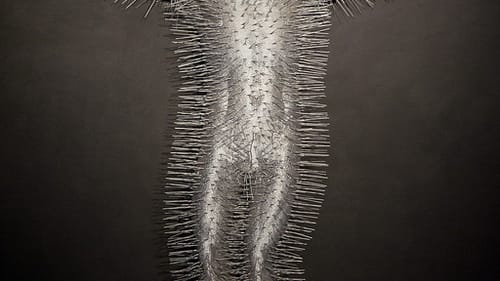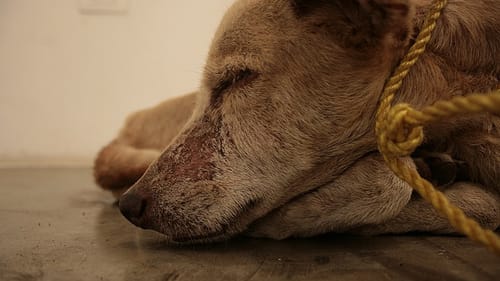Stay in the Loop
BSR publishes on a weekly schedule, with an email newsletter every Wednesday and Thursday morning. There’s no paywall, and subscribing is always free.
Making art out of other people's problems
Exploitation and social activism in modern art

When Isabelle proposed a museum installation based on an email I wrote her (which later became a BSR essay), I was intrigued with her interpretation of the narrative, which describes my experience with a prison art student, Billy, who was found dead hanging in his prison cell.
A proficient knitter, Isabelle proposed making two large, lacy banners, one with the text of my original email and the other with Billy’s self-portrait. I liked her proposed medium, lace, which suggests the fragility of life within the brutal structure of prison.
Isabelle’s proposal was rejected. There’s nothing new in rejection — someone said the folder of rejection is full at the end of an artist’s life — but the reason was surprising. Isabelle reports that “their reasoning was that I had little personal connection to the story and were concerned that I was taking advantage of the story for my art career.” In other words, exploiting my narrative.
I instantly envisioned the crucifixion and countless witnesses if personal connection to narrative is required; Rembrandt, Caravaggio, Velázquez, Messina, Dalí, and David Mach standing together in the field of Golgotha.
Whose narrative?
Much art is based upon narratives for which the artist doesn’t have a personal involvement. Of course, these narratives are often in the public domain, and the artist is free to find expression in them. But was what she proposed an example of exploitation?

Recently, the goal of art has shifted from beauty to social issues, as evidenced by the numerous art grants and foundations that support artists involved with social change. However, when art moves into social activism, it might exchange traditional mediums of painting, drawing, and such for the medium of living beings — human or nonhuman. When it does, exploitation is a potential outcome.
Exploiting animals . . .
Guillermo Vargas insisted tying a stray dog to a gallery’s wall was directed at raising social hypocrisy. Never confirmed, rumors suggested Vargas was going to starve the dog as part of the exhibition, an allegation Vargas denies, although he points out that no one helped the dog.
At the Aspen Art Museum, Cai Guo-Qiang tied iPads to the backs of three turtles. The tablets displayed videos of a ghost town; the artist’s stated intention was to show “the forgotten stories told by the perspective of a tortoise.” Animal rights activists protested, and the venue responded that “the museum provides a platform for artists to present their artistic vision with a freedom of expression.” Using animals, dead or alive, in art is far from uncommon. Should this be considered exploitation in a culture that eats animals?

. . . and humans
Even those who are undisturbed by the use of animals for artistic purposes, however, will probably object to causing emotional pain in children. Photographer Jill Greenburg paid parents to make their very young children cry (by giving them candy and then taking it away) so that she could photograph the “raw emotion.” Another photographer, Jonathan Hobin, photographed children reenacting tragic events, such as 9/11. Most would agree these are more troubling examples of exploitation.
How about an adult? Artist Gregor Schneider states he’d like to create a museum display of “someone nearing the end of their days. . .who wants to die in a humane and harmonious environment.” Can he justify such an exhibition by his intention of raising public consciousness to the beauty of death?
Who made artists the experts?
These exhibitions may not reflect the majority of social activist-artists, but they reflect, in extreme form, principles operating within the arts. And while there may be many artists doing great social change, these principles make me wonder how artists became experts of social activism — a role for which their training doesn’t exactly prepare them.
I have a bachelor’s in community mental health and a graduate degree in social work. I’ve worked in protective services for Philadelphia’s housing projects and family therapy at Philadelphia Child Guidance Clinic. I also trained as an artist, studying full-time for four years at Pennsylvania Academy of Fine Arts, and I have exhibited in galleries for the past 25 years. It has been my experience that training for social change and art are very different.
While both kinds of training incorporate the self, in art it is directed at developing the self as product — self-expression — and the training climate emphasizes developing reputation as an element in that product. In contrast, the self in social work is a tool directed beyond the self. I doubt anyone enters social work seeking wealth, fame, and the cover of ArtNews.
Self-expression is not privileged in social work, but it is very much in art. The tag of “genius,” rarely bestowed on social workers, has been given to numerous artists since Kant developed his aesthetics. Even though postmodern art has abandoned Kantian aesthetics, it hasn’t relinquished the genius label for artists.
Public vs. individual betterment
Genius or not, though, self-expression becomes problematic in social change. When dealing with interpersonal and intersocial dynamics, an I-other relationship is established. Within this relationship, personal expression and goals are kept in check because social change means public, not individual, betterment. All social workers know — or should — that their personal feelings and expressions are not only inadequate in creating affective social change, but may also be potentially destructive.
Keeping personal agendas in check is not easy, and the foundation of field training for social workers is supervision. In this supervisory relationship, social change is developed through accountability, compassion, and empathy for the other. What similar structure is provided within the arts to keep the artist accountable to participants, who may already be vulnerable to exploitation? Ethics, compassion, and empathy are not taught in art school. Are these even valued in the arts? Does accountability stand in opposition to individual artistic self-expression? And if the artist is not accountable to something beyond him- or herself, can it be considered social change art?
In social activism art the question is not “Is it art?” The more important question is, “Is it really social change?”
Sign up for our newsletter
All of the week's new articles, all in one place. Sign up for the free weekly BSR newsletters, and don't miss a conversation.

 Treacy Ziegler
Treacy Ziegler